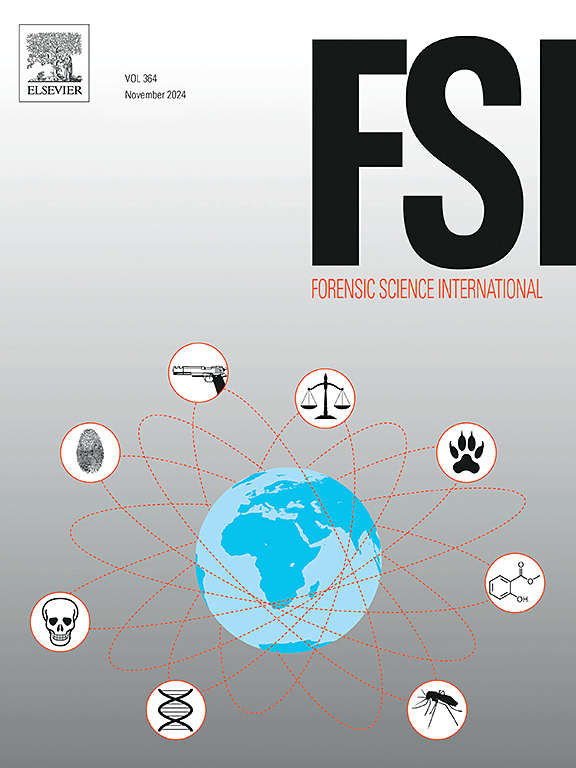GC/MS同时测定血液和尿液中9种安非他明和12种NPS类似物的方法的建立、验证和应用
IF 2.2
3区 医学
Q1 MEDICINE, LEGAL
引用次数: 0
摘要
苯丙胺类兴奋剂(ATS)、合成卡西酮(SC)和苯乙胺(PEA)给毒理学实验室带来了挑战。它们的广泛使用和滥用已导致全球中毒和死亡事件的增加。因此,为了更好地调查这些案件,所有毒理学实验室都需要新的分析方法来测定生物样本中的这些物质。本研究的目的是利用气相色谱-质谱联用技术,开发并验证测定全血和尿液中 9 种苯丙胺类兴奋剂、7 种氯苯类兴奋剂和 5 种苯乙醇胺的分析方法。样品经固相萃取预处理后用五氟丙酸酐衍生。21 种分析物的色谱分离在 11 分钟内完成。该方法的选择性、特异性、线性、检出限(LOD)和定量限(LOQ)、精密度、准确度和回收率均符合国际准则。分析物的检出限为 0.70 至 7.0 纳克/毫升,定量限为 2.0 至 20 纳克/毫升。21 种分析物的线性关系按物质组别分别为 2.0 ng/mL - 0.20 μg/mL、5.0 ng/mL - 0.50 μg/mL、10 ng/mL - 0.50 μg/mL、20 ng/mL - 0.50 μg/mL,R2 值均为 0.99。所有分析物的提取回收率均为 80%。方法的日内和日间准确度和精密度均在可接受的范围内。雅典国立和卡波迪斯特里安大学医学院法医学和毒理学系对送往该系进行毒理学调查的 46 个法医案件的死后血液和尿液样本采用了所开发的方法。分析结果显示,在 14 起案件中存在甲基苯丙胺、苯丙胺、亚甲二氧基甲基安非他明、MDA、伪麻黄碱、苯丙醇胺或 MBDB。本文章由计算机程序翻译,如有差异,请以英文原文为准。
Development, validation and applications of a GC/MS method for the simultaneous determination of 9 amphetamines and 12 NPS analogues in blood and urine
Amphetamine-type stimulants (ATS), synthetic cathinones (SCs) and phenethylamines (PEAs) pose a challenge to toxicology laboratories. Their extensive use and misuse has led to an increase of intoxications and fatal incidents worldwide. So, the need for new analytical methods for their determination in biological samples is crucial for all toxicology laboratories for a better investigation of these cases. The aim of this study was the development and validation of an analytical method for the determination of 9 ATS, 7 SCs and 5 PEAs in whole blood and urine using gas chromatography coupled with mass spectrometry. The samples were pretreated by solid-phase extraction and derivatized with pentafluoropropionic anhydride. Chromatographic separation of the 21 analytes was achieved in less than 11 min. The method was validated according to international guidelines for selectivity, specificity, linearity, limits of detection (LODs) and quantification (LOQs), precision, accuracy and recovery of the method. The LODs of the analytes ranged from 0.70 to 7.0 ng/mL and the values of the LOQs ranged from 2.0 to 20 ng/mL. The linearity of the 21 analytes, according to the group of substances, were 2.0 ng/mL – 0.20 μg/mL, 5.0 ng/mL – 0.50 μg/mL, 10 ng/mL – 0.50 μg/mL and 20 ng/mL – 0.50 μg/mL with R2 values > 0.99. Extraction recoveries were > 80 % for all analytes. Intra and inter day accuracy and precision of the method were within accepted limits. The developed method was applied to post-mortem blood and urine samples of 46 forensic cases sent for toxicological investigation to the Department of Forensic Medicine and Toxicology, School of Medicine, National and Kapodistrian University of Athens. The results of the analyses revealed the presence of methamphetamine, amphetamine, MDMA, MDA, pseudoephedrine, phenylpropanolamine or MBDB in 14 cases.
求助全文
通过发布文献求助,成功后即可免费获取论文全文。
去求助
来源期刊

Forensic science international
医学-医学:法
CiteScore
5.00
自引率
9.10%
发文量
285
审稿时长
49 days
期刊介绍:
Forensic Science International is the flagship journal in the prestigious Forensic Science International family, publishing the most innovative, cutting-edge, and influential contributions across the forensic sciences. Fields include: forensic pathology and histochemistry, chemistry, biochemistry and toxicology, biology, serology, odontology, psychiatry, anthropology, digital forensics, the physical sciences, firearms, and document examination, as well as investigations of value to public health in its broadest sense, and the important marginal area where science and medicine interact with the law.
The journal publishes:
Case Reports
Commentaries
Letters to the Editor
Original Research Papers (Regular Papers)
Rapid Communications
Review Articles
Technical Notes.
 求助内容:
求助内容: 应助结果提醒方式:
应助结果提醒方式:


